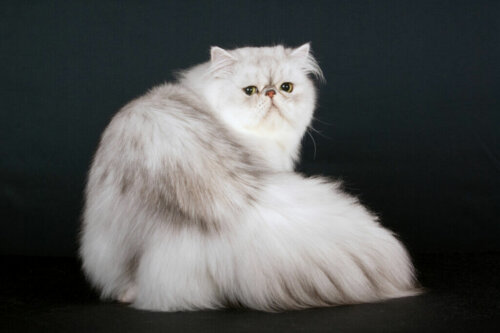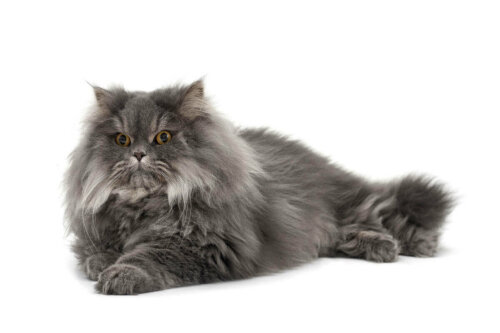What's the Origin of the Persian Cat?

The Persian cat is an unmistakable breed among domestic felines due to its abundant fur and broad, flattened face. We don’t know the exact date on which this type of cat first appeared, but some records indicate it’s quite old.
Crossbreeding with Angora cats had a lot to do with the creation of the breed as we know it today, as they both have long, straight fur. These originated in ancient Persia, hence their name, and were later introduced in Europe and America. Nowadays, these felines are popular all over the world.
Characteristics of Persian cats
Cats of this breed are usually medium to large in size and weigh between 7 and 11 pounds, although they can be heavier. The fluffy fur makes them look even bigger than they really are. The most characteristic feature of these felines is their round, broad brachycephalic head, large forehead, and prominent cheekbones.
Their eyes are also large, round and wide apart, brightly colored (blue, green, hazel, or heterochromatic). The nose is small and flat and the ears small, round, and covered with hair.
The hair of the Persian cat is long and silky and can be of different colors and patterns such as bicolor, tricolor, and brindle (with darker shades at the ends) or a single solid color like white, red, black, silver, gold, brown, etc.
These animals are tame and gentle and quite affectionate with the family. They also get along with other pets. You must brush them daily due to their long dense fur and have them visit a professional groomer to maintain the shape of their coat throughout the year.

When and where did the breed originate?
We don’t know for certain but we believe Persian cats date back to the early 17th century and originated in the area which is now known as Iran. Later, merchants introduced them to the European continent to places like Italy and France, where they became quite popular.
They arrived in England in the 19th century and were repeatedly crossed with Angora cats, with the aim of obtaining a longer and silkier coat. Persian cats were highly sought after, especially after they became popular among the royal family.
Queen Victoria owned many pets, and she had a black and white Persian cat named White Heather, who was her life companion. The first cat show was organized at the Crystal Palace in London, where the Persian breed was presented along with others like the Siamese cat.
The purpose of these exhibitions was to encourage the various breeding programs, in order to perpetuate the feline breeds and accentuate their characteristics. From these events began the various cat clubs, of which there are currently more than 150 registered.
After its success in Europe, the breed was exported to the USA, where the search for a more flattened face and small nose in this feline continued. This aggressive genetic selection has caused serious health problems in these animals.
Varieties of Persian cat
The breed as we know it today is the result of heavy selective breeding over the past few decades. There are many different variations of it and some of the most common are:
- Black Persian cat with orange eyes
- White with blue, orange, or disparate eyes
- Blue
- Red
- Off-white
- Smoky, with a light silver color at the root and in the middle of the coat and darker at the tips (this variation has different shades and ranges and is similar to the chinchilla color)
- Chinchilla
- Marbled, either silver, red or brown
- Persian tortoiseshell in black, red, off-white, white, bicolor, blue, and/or white
- Persian color point, with color at the ends.
The breeding of the Persian chinchilla cat
This feline breed is one of the most valued ones out there. In fact, 75% of the registered pedigree cats belong to it. However, the genetic selection that makes them so appealing has also taken its toll on their health. This is because up to 50% of Persian cats have kidney diseases associated with their genetics.
All cited sources were thoroughly reviewed by our team to ensure their quality, reliability, currency, and validity. The bibliography of this article was considered reliable and of academic or scientific accuracy.
- Helgren, J. Anne. (2006). «Cat Breed Detail: Persian Cats». Iams.com. Telemark Productions / Procter & Gamble.
- O’Neill, D. G., Romans, C., Brodbelt, D. C., Church, D. B., Černá, P., & Gunn-Moore, D. A. (2019). Persian cats under first opinion veterinary care in the UK: demography, mortality and disorders. Scientific Reports, 9(1), 1-13.
- Morrison, F. (1908). THE ARISTOCRATIC PERSIAN CAT. Country life in America, 446-483.